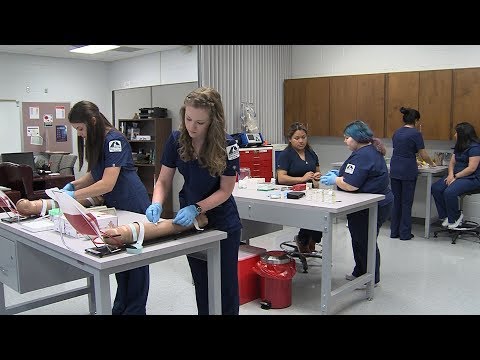Duties and Responsibilities of a Medical Laboratory Assistant
Contents
A medical laboratory assistant is responsible for a variety of tasks in the lab, including preparing samples, running tests, and maintaining equipment. They play a vital role in the lab, and their duties are essential to the smooth running of operations.
Checkout this video:
Introduction
A medical laboratory assistant (MLA) is a member of the healthcare team who performs routine technical tasks in a hospital or clinic setting. MLAs work under the direction of a medical technologist or other healthcare professional and are responsible for collecting and processing patient specimens, operating laboratory equipment, performing quality control tests, and maintaining laboratory records.
The duties and responsibilities of a medical laboratory assistant vary depending on the employer, but may include any or all of the following:
-Collecting and processing patient specimens
-Operating laboratory equipment
-Performing quality control tests
-Maintaining laboratory records
-Assisting with research projects
-Preparing slides for microscopy
-Sterilizing equipment
Job description
A medical laboratory assistant (MLA) is a person who performs routine technical support tasks in a medical laboratory under the supervision of a medical technologist or other health professional.
MLAs work in hospitals, clinics, and independent laboratories. They collect and process blood, urine, and tissue samples from patients. They also prepare these samples for testing by medical technologists, pathologists, and other laboratory personnel.
MLAs perform clerical duties such as ordering supplies, maintaining patient records, and billing insurance companies. They may also perform some basic lab tests, such as urinalysis and blood counts.
Education and Training
Most MLAs have an associate’s degree in medical laboratory technology from an accredited community college or technical school. Some MLAs may have a bachelor’s degree in life sciences or a related field.
Some MLAs complete a one-year certificate program in medical laboratory technology. These programs are offered by community colleges and technical schools. They include both classroom instruction and hands-on training in the lab.
Duties and responsibilities
A medical laboratory assistant is a vital member of the medical team who helps to collect and prepare samples for testing, as well as carrying out basic tests themselves. They may also be responsible for maintaining equipment and keeping accurate records.
The duties and responsibilities of a medical laboratory assistant vary depending on the specific role they are carrying out, but may include:
– Collecting blood, urine or tissue samples from patients
– Preparing samples for testing
– Carrying out basic tests such as blood counts or urinalysis
– Maintaining laboratory equipment
– Keeping accurate records of tests carried out and results obtained
– Providing support to other members of the medical team
Qualifications and skills
Medical laboratory assistants (MLAs) work in clinical laboratories and assist medical laboratory technologists (MLTs) with various testing procedures. They must have completed a medical laboratory assistant program, which is typically a one-year diploma or certificate program. In some cases, MLAs may have completed a two-year associates degree program.
Most MLAs work in hospitals, although some may also work in private clinics or research laboratories. They typically work full time, although some may work part time or on a casual basis.
MLAs must be able to follow instructions and have good attention to detail. They must be able to work independently and as part of a team. They must also be able to perform tasks such as drawing blood and handling specimens.
Work environment
medical laboratory assistants (MLA) work in hospitals, clinics and private laboratories. They work regular daytime hours, although some evening and weekend work may be required. Most MLAs work full time, but part-time and job-sharing positions are also available.
Laboratory assistants typically work in clean, well-lit and ventilated areas. They may be required to wear protective clothing such as gloves, masks and gowns when handling hazardous materials.
Salary and benefits
Medical Laboratory Assistants (MLAs) are responsible for performing a variety of technical and clerical tasks in support of medical laboratory activities. They may work in hospitals, clinics or private laboratories, and their duties vary depending on the specific laboratory in which they work. However, in general, MLAs are responsible for collecting and preparing samples for analysis, performing basic laboratory tests, and maintaining laboratory equipment and supplies. They may also be responsible for record-keeping and customer service tasks.
The salary for MLAs varies depending on the specific position, but is generally based on the MLA’s education level and experience. In addition to salary, most MLAs also receive benefits such as health insurance and paid vacation time.
Job outlook
MLAs are responsible for many different aspects of patient care. They may collect and process specimens, perform laboratory tests, assist in transfusions, prepare slides for microscopy, and enter patients’ test results into databases. They work under the supervision of medical technologists and pathologists.
Career paths
Research medical laboratory assistant programs.
Medical laboratory assistants (MLAs) support the work of medical laboratory technologists (MLTs), assisting with specimen collection and processing, conducting basic tests and performing routine maintenance on lab equipment. While MLAs are not required to have post-secondary education, many programs exist that can lead to a career in this field.
In order to become an MLA, you must complete a recognized medical laboratory assistant program. These programs are typically two years in length and offered at community colleges, vocational schools and some universities. Once you have completed the program, you will be eligible to write the Canadian Society for Medical Laboratory Science (CSMLS) certification exam. Upon successful completion of the exam, you will be registered as a certified medical laboratory assistant with the CSMLS.
Education and training
Medical laboratory assistants (MLAs) are allied health professionals who work in hospital laboratories and clinics, assisting medical technologists and pathologists in the analysis of patient samples. MLAs may also work in private reference laboratories, physician office laboratories, and public health facilities.
Most MLAs have completed a postsecondary medical laboratory assistant/medical laboratory technology (MLA/MLT) diploma or certificate program. These programs are offered by technical institutes, community colleges, and some universities across Canada. Admission requirements vary, but most programs require high school completion or equivalent with courses in biology and chemistry.
Most MLA/MLT programs include a period of clinical training in a hospital laboratory or other healthcare facility. Programs typically take two years to complete, although some may be completed in as little as 15 months.
Key takeaways
As a medical laboratory assistant (MLA), you will be responsible for various tasks related to the operation of a medical laboratory. These tasks may include collecting and preparing samples for testing, performing basic laboratory tests, and maintaining lab equipment. In some cases, you may also be responsible for supervising other lab personnel.
To be successful in this role, you will need to have strong attention to detail and good organizational skills. You should also be able to work well under pressure, as lab work is often time-sensitive. Additionally, it is important that you have good interpersonal skills, as you will be working closely with other members of the lab team.







